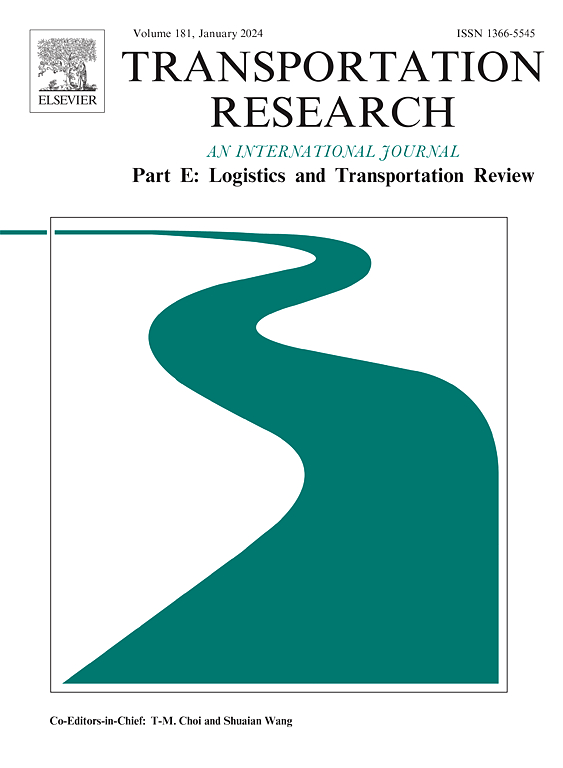Multiperiod line planning coordinately of urban rail transit by considering inter-period rolling stock connections
IF 8.8
1区 工程技术
Q1 ECONOMICS
Transportation Research Part E-Logistics and Transportation Review
Pub Date : 2025-03-19
DOI:10.1016/j.tre.2025.104084
引用次数: 0
Abstract
Traditional rail transit line planning concentrates on a single period (e.g., an hour), which ignores plan synchronization and potentially results in unavailability of rolling stocks between periods. A multiperiod line planning (MLP) method is proposed to create a coordinated and efficient full-day line plan. To represent plan coordination between periods, a macro and special train connection network is constructed to describe the dynamic transfer process of inter-period rolling stock from one train route to another. A bi-level optimization model based on the connection network is developed. The upper level formulates MLP problem with rolling stock connections as a mixed integer linear model, and constructs a descent direction search by considering the optimality conditions of the lower-level problem. The lower level is a passenger flow assignment problem, solved using a label-setting algorithm. Finally, an empirical investigation of Beijing subway line 1 is conducted to validate the effectiveness of the proposed method. Results show that the multiperiod coordination plan effectively saves operation cost by 13.6% and passenger travel time by 3.45%, compared to the actual line plan. Besides, the impacts of rolling stock connections on multiperiod line plans become significant when system capacity is tight.
考虑跨期车辆衔接的城市轨道交通多期线路协调规划
传统的轨道交通线路规划集中在一个时间段(例如,一个小时),这忽略了计划的同步性,并可能导致时间段之间的车辆不可用。提出了一种多周期线路规划方法,以建立协调高效的全日线路规划。为了表示时段间的计划协调,构建了一个宏观和专用的列车连接网络来描述跨时段车辆从一条列车路线到另一条列车路线的动态转移过程。建立了基于连接网络的双层优化模型。上层将轨道车辆连接的MLP问题表述为一个混合整数线性模型,并考虑下层问题的最优性条件,构造一个下降方向搜索。下层是客流分配问题,使用标签设置算法解决。最后,以北京地铁1号线为例进行了实证研究,验证了本文方法的有效性。结果表明,与实际线路方案相比,多时段协调方案有效节约运营成本13.6%,节约旅客出行时间3.45%。此外,在系统容量紧张的情况下,车辆连接对多时段线路规划的影响尤为显著。
本文章由计算机程序翻译,如有差异,请以英文原文为准。
求助全文
约1分钟内获得全文
求助全文
来源期刊
CiteScore
16.20
自引率
16.00%
发文量
285
审稿时长
62 days
期刊介绍:
Transportation Research Part E: Logistics and Transportation Review is a reputable journal that publishes high-quality articles covering a wide range of topics in the field of logistics and transportation research. The journal welcomes submissions on various subjects, including transport economics, transport infrastructure and investment appraisal, evaluation of public policies related to transportation, empirical and analytical studies of logistics management practices and performance, logistics and operations models, and logistics and supply chain management.
Part E aims to provide informative and well-researched articles that contribute to the understanding and advancement of the field. The content of the journal is complementary to other prestigious journals in transportation research, such as Transportation Research Part A: Policy and Practice, Part B: Methodological, Part C: Emerging Technologies, Part D: Transport and Environment, and Part F: Traffic Psychology and Behaviour. Together, these journals form a comprehensive and cohesive reference for current research in transportation science.

 求助内容:
求助内容: 应助结果提醒方式:
应助结果提醒方式:


